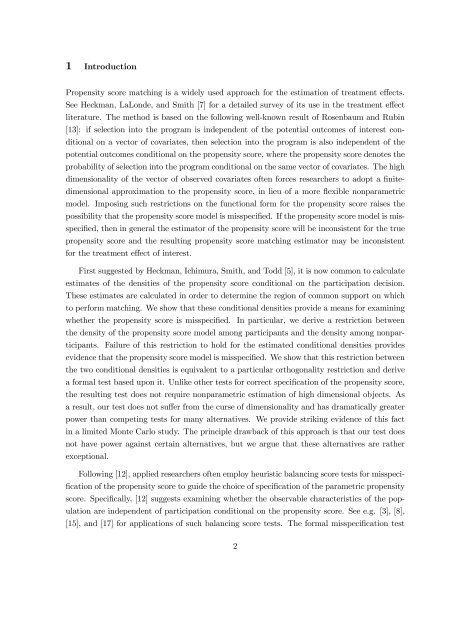On the Identification of Misspecified Propensity Scores - School of ...
On the Identification of Misspecified Propensity Scores - School of ...
On the Identification of Misspecified Propensity Scores - School of ...
You also want an ePaper? Increase the reach of your titles
YUMPU automatically turns print PDFs into web optimized ePapers that Google loves.
1 Introduction<br />
<strong>Propensity</strong> score matching is a widely used approach for <strong>the</strong> estimation <strong>of</strong> treatment effects.<br />
See Heckman, LaLonde, and Smith [7] for a detailed survey <strong>of</strong> its use in <strong>the</strong> treatment effect<br />
literature. The method is based on <strong>the</strong> following well-known result <strong>of</strong> Rosenbaum and Rubin<br />
[13]: if selection into <strong>the</strong> program is independent <strong>of</strong> <strong>the</strong> potential outcomes <strong>of</strong> interest con-<br />
ditional on a vector <strong>of</strong> covariates, <strong>the</strong>n selection into <strong>the</strong> program is also independent <strong>of</strong> <strong>the</strong><br />
potential outcomes conditional on <strong>the</strong> propensity score, where <strong>the</strong> propensity score denotes <strong>the</strong><br />
probability <strong>of</strong> selection into <strong>the</strong> program conditional on <strong>the</strong> same vector <strong>of</strong> covariates. The high<br />
dimensionality <strong>of</strong> <strong>the</strong> vector <strong>of</strong> observed covariates <strong>of</strong>ten forces researchers to adopt a finite-<br />
dimensional approximation to <strong>the</strong> propensity score, in lieu <strong>of</strong> a more flexible nonparametric<br />
model. Imposing such restrictions on <strong>the</strong> functional form for <strong>the</strong> propensity score raises <strong>the</strong><br />
possibility that <strong>the</strong> propensity score model is misspecified. If <strong>the</strong> propensity score model is mis-<br />
specified, <strong>the</strong>n in general <strong>the</strong> estimator <strong>of</strong> <strong>the</strong> propensity score will be inconsistent for <strong>the</strong> true<br />
propensity score and <strong>the</strong> resulting propensity score matching estimator may be inconsistent<br />
for <strong>the</strong> treatment effect <strong>of</strong> interest.<br />
First suggested by Heckman, Ichimura, Smith, and Todd [5], it is now common to calculate<br />
estimates <strong>of</strong> <strong>the</strong> densities <strong>of</strong> <strong>the</strong> propensity score conditional on <strong>the</strong> participation decision.<br />
These estimates are calculated in order to determine <strong>the</strong> region <strong>of</strong> common support on which<br />
to perform matching. We show that <strong>the</strong>se conditional densities provide a means for examining<br />
whe<strong>the</strong>r <strong>the</strong> propensity score is misspecified. In particular, we derive a restriction between<br />
<strong>the</strong> density <strong>of</strong> <strong>the</strong> propensity score model among participants and <strong>the</strong> density among nonpar-<br />
ticipants. Failure <strong>of</strong> this restriction to hold for <strong>the</strong> estimated conditional densities provides<br />
evidence that <strong>the</strong> propensity score model is misspecified. We show that this restriction between<br />
<strong>the</strong> two conditional densities is equivalent to a particular orthogonality restriction and derive<br />
a formal test based upon it. Unlike o<strong>the</strong>r tests for correct specification <strong>of</strong> <strong>the</strong> propensity score,<br />
<strong>the</strong> resulting test does not require nonparametric estimation <strong>of</strong> high dimensional objects. As<br />
a result, our test does not suffer from <strong>the</strong> curse <strong>of</strong> dimensionality and has dramatically greater<br />
power than competing tests for many alternatives. We provide striking evidence <strong>of</strong> this fact<br />
in a limited Monte Carlo study. The principle drawback <strong>of</strong> this approach is that our test does<br />
not have power against certain alternatives, but we argue that <strong>the</strong>se alternatives are ra<strong>the</strong>r<br />
exceptional.<br />
Following [12], applied researchers <strong>of</strong>ten employ heuristic balancing score tests for misspeci-<br />
fication <strong>of</strong> <strong>the</strong> propensity score to guide <strong>the</strong> choice <strong>of</strong> specification <strong>of</strong> <strong>the</strong> parametric propensity<br />
score. Specifically, [12] suggests examining whe<strong>the</strong>r <strong>the</strong> observable characteristics <strong>of</strong> <strong>the</strong> pop-<br />
ulation are independent <strong>of</strong> participation conditional on <strong>the</strong> propensity score. See e.g. [3], [8],<br />
[15], and [17] for applications <strong>of</strong> such balancing score tests. The formal misspecification test<br />
2
















